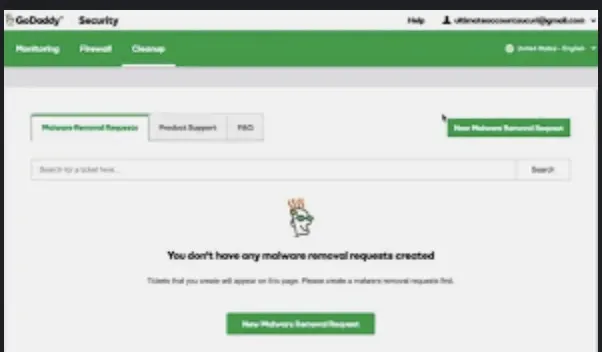GoDaddy Website Firewall is a powerful security solution designed to protect your online presence from threats and website security issues.
If users encounter an “Access Denied” message while visiting your site, it typically means their IP has been blocked due to specific configurations.
To rectify this, site owners can easily whitelist their IPs through the firewall settings or by submitting a GoDaddy support ticket, ensuring that all necessary block details are included for swift resolution.
By understanding the functionality of the GoDaddy Website Firewall, you can maintain a safer online environment while minimizing interruptions for legitimate visitors.
Ultimately, enhancing your website’s security approach with GoDaddy ensures better protection against unauthorized access and fraudulent activities.
The GoDaddy Website Firewall serves as a critical barrier against various online threats that can compromise your site’s integrity. It helps manage access permissions, ensuring that only authorized users can view your content, thus reducing the likelihood of experiencing access errors.
If an individual finds themselves unable to access a page due to a block, they may need to consider alternative measures, such as submitting a request for IP whitelisting or seeking assistance through GoDaddy’s support channels. By effectively utilizing these security features, website managers can significantly mitigate risks associated with security breaches and maintain a seamless user experience.
Understanding GoDaddy Website Firewall Restrictions
When a visitor encounters an ‘Access Denied’ message on a GoDaddy-hosted website, it indicates that the GoDaddy Website Firewall has identified a potential threat or violation of the website’s access policies. These restrictions can stem from various factors, including the visitor’s geographic location or specific IP address behavior. If you’re managing a website that has seen this kind of block, it’s crucial to understand the implications of these security measures. They are designed to protect your site from unauthorized access and potential attacks, but they can also inadvertently restrict legitimate users.
In situations where users are blocked, it is recommended to check the block details provided by the firewall. Information such as the block ID, reason, and other related data can help you assess why the access was restricted. For instance, if the reason cites ‘Access from your Country was disabled by the administrator,’ there may be a need to adjust the settings within your website’s firewall rules to allow legitimate traffic from that location.
Frequently Asked Questions
What should I do if I’m receiving an ‘access denied’ message from the GoDaddy Website Firewall?
If you see an ‘access denied’ message from the GoDaddy Website Firewall, it usually means your IP has been blocked. You can whitelist your IP by accessing your GoDaddy account or by opening a support ticket with GoDaddy customer service to review the block details.
How can I whitelist my IP address on GoDaddy’s Website Firewall?
To whitelist your IP address on the GoDaddy Website Firewall, log in to your GoDaddy account. Navigate to your security settings where you can find options to manage firewall settings. Here you can add your IP address to the whitelist to prevent future access issues.
What information do I need to include in my GoDaddy support ticket about the Website Firewall?
When submitting a support ticket regarding the GoDaddy Website Firewall, include necessary block details such as your IP address, URL accessed, block ID, and the specific block reason such as access being disabled from your country. This information helps GoDaddy support review your issue effectively.
How can I find the block details for my GoDaddy Website Firewall issue?
Block details can usually be found in the ‘access denied’ message displayed by the GoDaddy Website Firewall. This message will include your IP address, URL, browser details, block ID, and the reason for the block, which you can use when contacting GoDaddy support for assistance.
What causes access blocks on GoDaddy’s Website Firewall?
Access blocks on the GoDaddy Website Firewall can occur due to various reasons, including location-based restrictions or perceived suspicious activity from a specific IP address. These measures help protect website security by preventing unauthorized access.
How does GoDaddy Website Firewall protect my website?
The GoDaddy Website Firewall protects your website by filtering out malicious traffic and preventing access based on certain predefined rules. It scans incoming requests and blocks those that exhibit suspicious behavior, ensuring a safer online environment for your site.
Can I check for website security issues on my site protected by GoDaddy Website Firewall?
Yes, you can check for security issues on your site secured by the GoDaddy Website Firewall by reviewing security logs and alerts in your GoDaddy account dashboard. This will provide insights into any potential security threats or blocked access attempts.
| Key Point | Details |
|---|---|
| Access Denied | The website access is restricted based on geographical location. |
| Whitelisting IP | Site owners need to whitelist their IP to regain access. |
| Support Ticket | Users can contact support if they think the block is a mistake. |
| Block Details | Users should provide block details like IP and URL for assistance. |
| Block Reason | Access from the user’s country has been disabled by the administrator. |
| Time of Block | The block occurred on 2025-08-15 at 23:15:53. |
Summary
GoDaddy Website Firewall is essential for maintaining online security. It protects websites from malicious access, but may inadvertently block legitimate users from accessing the site. If you encounter an access denied message, first check if your IP needs to be whitelisted. If not, reaching out to GoDaddy’s support with the provided block details will help resolve the issue. It’s crucial to understand the block reasons to ensure smooth and secure website management.
#GoDaddy #WebsiteFirewall #AccessDenied #WebSecurity #TechSupport








